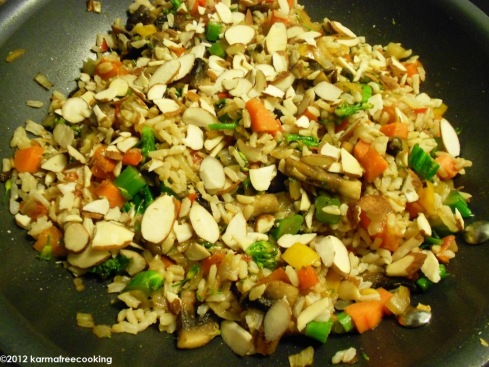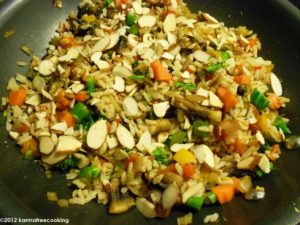How To BeE A Happy Latino Vegetarian

 By Madelyn, Mi Soul Latino
By Madelyn, Mi Soul Latino
Some people believe the adjectives Latino and Vegetarian could never go together – an oxymoron of sorts. I can even understand a bit why some people might believe that. See, I come from Puerto Rico, the land of “lechón asado’ a la varita”, “bistéc encebollado”, “arroz con salchichas” and “mofongo con mucho, mucho chicharrón”. Who, growing up around all that, would ever decide to be a vegetarian?? Well, I am Madelyn and I am a Puerto Rican Vegetarian. I am not a figment of anyone’s imagination but a healthy driven woman who stumbled upon vegetarianism by pure serendipity. Nothing planned….nothing schemed – just fate, destiny and a little bit of karma all doing their thing.
People often ask me how I decided to become a vegetarian. Many of them believe it is a decision you just make one day and BOOM – you immediately stop craving any meat products. While there are  many people who might have done it that way, this was not my case. It took me nearly 4 years from the moment I started to entertain a vegetarian lifestyle to the moment I decided to seriously try to be a vegetarian.
many people who might have done it that way, this was not my case. It took me nearly 4 years from the moment I started to entertain a vegetarian lifestyle to the moment I decided to seriously try to be a vegetarian.
My first step was not to eat meat products at home. I figured I ate out often enough to be able to eat only vegetarian foods at home. After doing that, for some time, I noticed I started craving less and less meat when I was ordering out in restaurants. Then, I changed the way I shopped at regular supermarkets. I stopped buying canned goods, regular carbonated drinks or foods with artificial colorings and chemical ingredients that I couldn’t even pronounce. Instead, I started buying foods made with whole grains, as well as being more informed on fresher choices. I also took some vegetarian cooking classes to help me shift the way I looked at foods and to learn about new options for ingredients.

If you might be considering to adopt a more vegetarian lifestyle but do not know where to start, I say – START SMALL. Break it down into smaller steps and you’ll be more likely to be successful. Here are some ideas you can implement yourself:
Decide what is your least favorite meat product and stop eating it first.
For most people it’s red meat, for others it’s seafood. Whatever it is for you, it’ll be easier to leave what you like the least. Little by little, you might decide to stop eating some another meat product and then another and another.
Make a conscious decision to not eat meat several days a week.
Start with two days. Some people implement Meatless Mondays, which is a movement in the US and the UK to help promote healthier eating and a healthier environment. You’ll still have five other days to eat “whatever” else you like. You’ll start seeing the difference in how you feel on those days. Maybe you’ll like the recipes and choices you make on your “vegetarian” days so much that you’ll unconsciously increase them little by little.
Start planning your meals with a larger quantity of fresh products – more fruits and vegetables.
Make lasagna filled with mixed vegetables or spinach instead of ground meat. Include more fruits in your breakfast – like fruit saladsor fruit smoothies. Always include a salad with at least 3-4 fresh ingredients as a side dish. Throughout the day, eat fresh fruits as snacks.
Redefine your dinner plate – look at the rice, the pasta or a casserole as the main part of your dish.
Think of vegetable rice or spinach and mushroom risotto as the main dish. To me, a macaroni and cheese or vegetable lasagna with a side salad and plantains is a well-rounded meal. Pastelones, sweet potatoes, rice, and a variety of vegetables and vegetable proteins eaten alongside a nice salad is a complete meal.
Experiment cooking with ingredients that are new to you. For me, it was getting to know sun-dried tomatoes, the different varieties of mushrooms (button, portobello, cremini, shitake, porcini, enoki, trumpets, etc.), the different varieties of lettuces (Romaine, Boston bib, arugula, frisee, mesclun greens, endive, radicchio, etc.), sugar snap peas, leeks, artichokes, polenta, tofu, textured soy protein, quinoa, kelp, umemboshi paste, agar agar, brown rice syrup, agave nectar, rice pastas, panko breadcrumbs, and countless others.
Take some vegetarian cooking classes and visit vegetarian websites or blogs (wink, wink) for recipe ideas.
Many Hispanics shy away from a vegetarian lifestyle because they believe they’d have to live without their favorite home-cooked recipes. In my vegetarian blog, KarmaFree Cooking, you’ll learn how to make these traditional recipes anew. You’ll see that making a vegetarian sancocho is just as good as your traditional meaty recipe. Pasteles taste great with a mixed vegetable filling, a soy picadillo is delicious over rice or macaroni and even a bacalaíto can be made without the salted cod fish (bacalao) and still taste great. Most of the flavors come from the seasoning and not from the animal products.
I hope these ideas will help you see that living a vegetarian lifestyle is not as daunting as you may have thought. Even if going vegetarian is not the thing for you, integrating some of these ideas into your lifestyle will definitely have you eating better and more healthful. Try it – you’ll not regret it!
Share Your Voice. Connect.
Do you integrate Latino vegetarian dishes into your diet? Or do you think it’s just too much for you?
This article was first published in Mi Soul Latino.
Madelyn is a lacto-vegetarian living in San Juan, Puerto Rico. She became a vegetarian after seriously beginning to practice Yoga more than 10 years ago. Over the years, she developed an increased appreciation for cooking and developing recipes. For Madelyn, being vegetarian goes beyond just not eating meat or animal products. It has to do with having the most natural and organic lifestyle possible – avoiding soft drinks, chemical additives and medications, canned foods, or foods cooked a long time ago. Tired of listening to the bad rep Vegetarian cooking had she started the vegetarian blog KarmaFree Cooking in 2007, as way to share how a vegetarian lifestyle and diet is something delicious, healthful, easy to follow and enjoy.
[Photos by KarmaFree Cooking]

